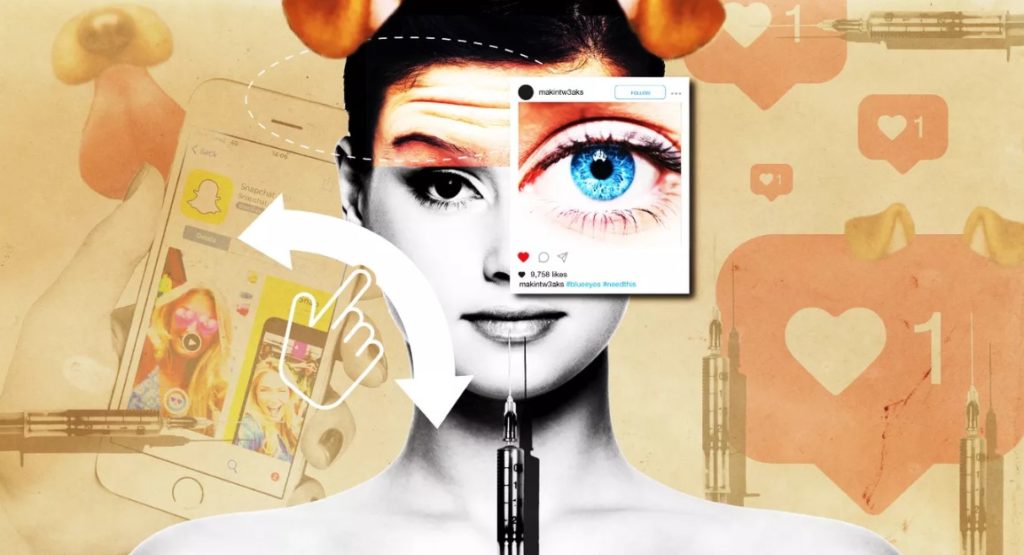
Grace Smith*, 28, started using the Facetune photo app a few years back to edit wrinkles out of her face.
The lines between her eyebrows created a shadowy effect on her forehead, and she thought she looked fresher and prettier in pictures when the shadow was erased.
Pretty soon, the touched-up photos made the Washington, DC, health coach long to “edit” her wrinkles out in real life. “If I already have an indent in my forehead [now], how bad is it going to be when I’m 60?” she wondered.
So at age 23, Smith turned to Botox, a local injection that causes facial wrinkles to smooth out, for a real-life fix. Five years later, she’s still getting injections into her forehead every nine months. She’s also had her lips filled and her skin lasered “because it didn’t look pretty on camera.” And for now, she feels satisfied. She hardly edits her photos anymore, she says, because “I don’t have the shadow.”
Smith’s dermatologist, Noëlle Sherber, says Smith is part of a new wave in plastic surgery: people seeking to permanently alter their faces, inspired by touched-up or filtered photos of themselves.
“I have a lot of millennials as part of my practice,” she told me. “Most of the time, they want to talk about how they appear in their edited photos. And they are looking to explore options of how to translate that into reality.”
Sherber, who runs a DC dermatology and plastic surgery practice with her husband, says these patients have become accustomed to seeing their faces in a digitally altered state. They blur imperfections, plump their lips, thin out their noses, and brighten their skin — or sometimes go even further, enlarging their eyes and changing the proportions of their face.
They often forget that the images on their smartphone aren’t reality, that there’s a big difference between making a nose or chin look smaller on camera and moving bone or tissue with surgery, Sherber says.
“Some of the changes they are making to their faces are not achievable,” she added. “We can’t do that in real life. And if they really can’t be made to match that, they will be inherently disappointed.”
In other words, the edited and filtered photos create an alternate reality, and, along with it, unrealistic expectations about how people should look — and what cosmetic treatments can do for them. And doctors are increasingly warning that this may also be fueling a disturbing psychological phenomenon: “Snapchat dysmorphia.”
“Snapchat dysmorphia” isn’t just a beauty trend; it’s an alarming psychological phenomenon
The smartphone age has turned us into prolific photographers. And many people choose to turn the camera lens on themselves, in selfies broadcast through Instagram, Facebook, Snapchat, or text. These photos can be easily edited and filtered with a tempting array of tools, like Snapseed or Facetune or filters on Snapchat. So anybody with a smartphone has instant access to the kind of touch-ups that used to be reserved only for celebrities and models.
The blurred lines between smartphone fantasy and reality, along with shifting beauty ideals, is taking a psychic toll, and doctors are calling it Snapchat dysmorphia.
“It can be argued that these apps are making us lose touch with reality because we expect to look perfectly primped and filtered in real life as well,” doctors at Boston University School of Medicine’s Department of Dermatology wrote in a new JAMA Facial Plastic Surgery article.
Edited and filtered photos can exacerbate body dysmorphic disorder, the relentless fixation with a perceived flaw in appearance. “Now, it is not just celebrities propagating beauty standards: it is a classmate, a coworker, or a friend,” the doctors wrote.
“The pervasiveness of these filtered images can take a toll on one’s self-esteem, make one feel inadequate for not looking a certain way in the real world, and may even act as a trigger and lead to body dysmorphic disorder.”
Even more disturbing, the selfies people bring into clinics, even when they’re unedited, can be inaccurate portrayals of how a person actually looks. Another recent JAMA article noted that selfies can make the nose appear 30 percent larger, and that patients seeking nose jobs based on selfies should be aware of this distortion.
According to the American Academy of Facial Plastic and Reconstructive Surgeons 2017 poll, 55 percent of facial plastic surgeons reported seeing patients who wanted surgeries to help them look better in selfies, up from 13 percent in 2016.
Boris Paskhover, a facial plastic surgeon at Rutgers University and author on the nose job paper, warned, “Any time people are using a front facing camera at close proximity — for FaceTime, SnapChat, Instagram,” it’s going to change their face. But right now, he said, “People don’t get it.” And they’re turning to expensive and permanent fixes based on these distorted images.
“Just because the app shows what you may look like if you reduce your nose or any body part doesn’t mean that it’s possible in real life,” Paskhover warned. “I can’t just move your nose around. I have to adjust the skin, the bones, the cartilage.”
The fact that people need to be reminded of that should make us pause and consider what social media and smartphones are bringing to the surface.























